Design of Double Load Cells for Electronic Platform Scale
This article is a design of electronic platform scale with double load cells for large tare and small load.
Case of the large tare and small load: The charging bucket weight is about 300kg but the material to be measured is only 15kg, the required accuracy is 0.05%FS under static measurement. According to the actual needs of the production line, the electronic platform scale structure can be used to complete the project.
At present, there are three methods for tare balance at home and abroad, namely the leverage balance method, the balance method of adjusting the reverse voltage of differential amplifier and the balance method of changing bridge arm resistance of strain gauge load cell. Among the three methods, the balance method of adjusting the reverse voltage of differential amplifier and changing bridge arm resistance of strain gauge load cell can simply balance and remove tare. The electronic scales based on above two balance methods still need to complete measurement with the large capacity load cells, only the electronic scales based on leverage balance method can use the low capacity load cells. However, the leverage balance method is more complex than the other two methods and would introduce errors, thus affecting the accuracy of electronic scales. Meanwhile, these three balance methods are mostly used in the electronic scales on industrial production lines of the burdening and packing fields, they are rarely used in the electronic platform scale structure. To ensure not only the balanced tare removal, but also the accuracy requirements of the electronic platform scale, it's found after research that the method of double leverage balance and the measurement method of digital low capacity dual load cells can achieve the goal of balancing or reducing large tare, improving the resolution and accuracy of electronic platform scale.
I. Principle of Electronic Platform Scale Structure
1. Principle of Scale Structure
The leverage balance method used in the electronic platform scale is to put the charging bucket (weighed object) on the scale's upper table and place at one end of the lever respectively through the four ball-end stanchions, while a counter-weight is placed at the other end of the lever, thus reducing the force on the load cell appropriately.
When a counter-weight is properly selected, the force acting on the load cell is proportional to the weight of weighed object. When an appropriate leverage ratio is selected, it will be easy to balance a certain tare, thus avoiding the disadvantage that large tare takes up most effective A/D conversion significant digits of load cell signals and thus reduces the resolution of electronic scale.
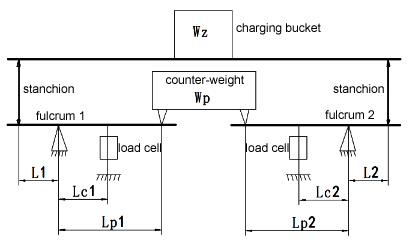
The reason for applying the double levers structure and double load cells measurement form in the electronic platform scale is to guarantee the symmetry and balance of the scale's overall structure on the one hand. On the other hand, it will be easier to adjust the errors at four corners of the electronic platform scale. Namely adjusting the offset load error of the platform scale firstly through the load cell, and then adjusting the angle difference of corresponding side. In order to ensure the accuracy of electronic scale, the structural rationality of levers should also be carefully considered.
2. Structure of main components
The electronic platform scale body structure is shown as follows:
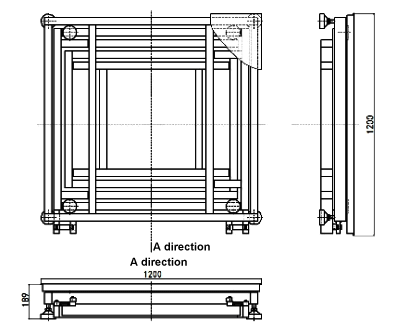
Outline dimensions of the electronic platform scale are 1200 mm in length, 1200 mm in width and 189 mm in height. The electronic platform scale consists of upper table, supporting table (namely the lower table), two sets of levers, counter-weight blocks, two load cells, two digital modules, junction boxes and digital load cell controllers. The upper table is supported by four floating stanchions on the bottom and the four floating stanchions are pinned at one end of the two sets of levers respectively. The two load cells and counter-weight blocks are connected and hung at the other end of the two sets of levers. To facilitate the load cell installation, maintenance and the platform scale debugging, the two load cells and junction boxes are mounted on the outside of the supporting counter-top (namely the lower counter-top), two digital modules are installed in the junction box and the junction box is connected with the digital controller.

In the platform scale structure, the load cells and load cell junction box are mounted on the outside of the supporting counter-top (namely the lower counter-top) to facilitate the maintenance while guaranteeing the easy installation and debugging of load cells and junction box.
2.1 Double Lever Structure
The fulcrum of each lever on the electronic platform scale is divided into two parts according to the structure and stability of the platform scale, namely each lever adopts a double-arm beam structure. In the direction of vertical lever arm, it is suspended on one of the middle beams of the quadrilateral structure of platform scale supporting platform (namely the lower platform), the two levers pass under the middle beam corresponding to the leverage and interlace with each other, so as to ensure the counter-weight arm to be as long as possible and reduce the weight of counter-weight. Four floating stanchions are respectively pressed on the connecting suspension beam of two levers' short arms (the suspension point and fulcrum have same structure), while the counter-weight beam is suspended on the long arm of the two levers, such a structure ensures that the counter-weight and the charging bucket's lateral force have little influence on the accuracy of the lever and platform scale.
2.2 Structure of Floating Stanchion
Structure of the floating stanchion consists of rubber body, ball-end stanchion and ball-end apex, the ball-end apex is respectively fixed on the connecting suspension beam of the two levers' short arm ends, the ball-end stanchions are mounted on the top of the ball head and the rubber body and ball-end stanchions are integrated. One platform scale needs four sets of floating supports, and the four rubber bodies are supported in four flat-bottomed sockets at the lower part of the upper table of the platform scale, therefore, the upper table of platform scale is connected with two levers by four sets of floating supports, which is similar to the structure of a common platform scale with four load cell ball-end presses or 'tumbler' presses supporting, so as to ensure that the accuracy of platform scale is not affected by the deformation of scale's upper table and the charging bucket's impact.
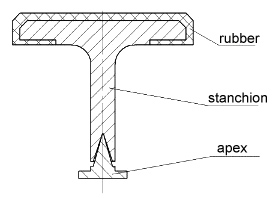
2.3 Structure of Lever Fulcrum
In addition to the four supports at four corners of the supporting table (namely the lower table) and the four floating pillars below the upper table, other fulcrums, supports or floating connections of the platform scale are all structured in the form of lever fulcrum, the lever fulcrum structure consists of adjusting gasket, flat gasket, bolt, spring shim and thin steel belt, and the lever fulcrum adopts a suspension structure. The fulcrum without common knife and bearing usually has the disadvantages of wear, swing, micro-displacement and difficult to fine-tune the lever-arm ratio of the fulcrum structure.
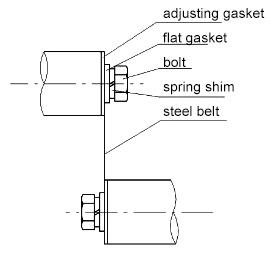
Such a suspension structure can ensure the accurate positioning and stability of fulcrum while reducing or eliminating the effect of lateral force or moment on levers and load cells. When adjusting the platform scale's eccentric load, it's also convenient to adjust the gasket thickness or the slight length of lever arm to ensure that the offset load error of platform scale is within the standard range.
II. Selection of Load cells and Digital Controllers
Finally, aluminum single point load cells with parallel beam are selected.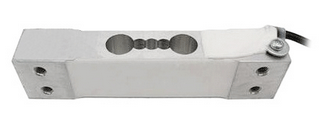 The two load cells capacities are both 15kg. Weighing instruments
that is easily compatible with digital module are chosen as the digital controller, which fully meets the requirements of the platform scale. The digital module selected by this platform scale has a high
non-linearity of 0.001% and the internal precision of ±1050000
(A/D20bit), its applicable temperature range is from -10°C to +50°C with
an acquisition speed higher than 100 times/s.
The two load cells capacities are both 15kg. Weighing instruments
that is easily compatible with digital module are chosen as the digital controller, which fully meets the requirements of the platform scale. The digital module selected by this platform scale has a high
non-linearity of 0.001% and the internal precision of ±1050000
(A/D20bit), its applicable temperature range is from -10°C to +50°C with
an acquisition speed higher than 100 times/s.
As a digital weighing system, the platform scale is the same as the common weighing system whose digital load cell uses the highly integrated and intelligent processing unit in the load cell or in the load cell junction box to complete pre-processes, such as A/D conversion of analog signal and filtering, and then output digital signal after digital compensation. The digital weighing instrument or computer collects the output data of load cells in real time, and then processes and displays the data. Its main characteristics are as follows:
III. Conclusion
With the rapid development of modern manufacturing industry, the demand for automatic production lines of products has been increasing. As the electronic scales for control and measurement will be more and more, platform scales similar to such large tare and small load are often used. The above platform scale has been calibrated and used on site. It meets the weighing measurement requirements of the production line and to obtain user satisfaction.
Case of the large tare and small load: The charging bucket weight is about 300kg but the material to be measured is only 15kg, the required accuracy is 0.05%FS under static measurement. According to the actual needs of the production line, the electronic platform scale structure can be used to complete the project.
At present, there are three methods for tare balance at home and abroad, namely the leverage balance method, the balance method of adjusting the reverse voltage of differential amplifier and the balance method of changing bridge arm resistance of strain gauge load cell. Among the three methods, the balance method of adjusting the reverse voltage of differential amplifier and changing bridge arm resistance of strain gauge load cell can simply balance and remove tare. The electronic scales based on above two balance methods still need to complete measurement with the large capacity load cells, only the electronic scales based on leverage balance method can use the low capacity load cells. However, the leverage balance method is more complex than the other two methods and would introduce errors, thus affecting the accuracy of electronic scales. Meanwhile, these three balance methods are mostly used in the electronic scales on industrial production lines of the burdening and packing fields, they are rarely used in the electronic platform scale structure. To ensure not only the balanced tare removal, but also the accuracy requirements of the electronic platform scale, it's found after research that the method of double leverage balance and the measurement method of digital low capacity dual load cells can achieve the goal of balancing or reducing large tare, improving the resolution and accuracy of electronic platform scale.
I. Principle of Electronic Platform Scale Structure
1. Principle of Scale Structure
The leverage balance method used in the electronic platform scale is to put the charging bucket (weighed object) on the scale's upper table and place at one end of the lever respectively through the four ball-end stanchions, while a counter-weight is placed at the other end of the lever, thus reducing the force on the load cell appropriately.
When a counter-weight is properly selected, the force acting on the load cell is proportional to the weight of weighed object. When an appropriate leverage ratio is selected, it will be easy to balance a certain tare, thus avoiding the disadvantage that large tare takes up most effective A/D conversion significant digits of load cell signals and thus reduces the resolution of electronic scale.

The reason for applying the double levers structure and double load cells measurement form in the electronic platform scale is to guarantee the symmetry and balance of the scale's overall structure on the one hand. On the other hand, it will be easier to adjust the errors at four corners of the electronic platform scale. Namely adjusting the offset load error of the platform scale firstly through the load cell, and then adjusting the angle difference of corresponding side. In order to ensure the accuracy of electronic scale, the structural rationality of levers should also be carefully considered.
2. Structure of main components
The electronic platform scale body structure is shown as follows:

Outline dimensions of the electronic platform scale are 1200 mm in length, 1200 mm in width and 189 mm in height. The electronic platform scale consists of upper table, supporting table (namely the lower table), two sets of levers, counter-weight blocks, two load cells, two digital modules, junction boxes and digital load cell controllers. The upper table is supported by four floating stanchions on the bottom and the four floating stanchions are pinned at one end of the two sets of levers respectively. The two load cells and counter-weight blocks are connected and hung at the other end of the two sets of levers. To facilitate the load cell installation, maintenance and the platform scale debugging, the two load cells and junction boxes are mounted on the outside of the supporting counter-top (namely the lower counter-top), two digital modules are installed in the junction box and the junction box is connected with the digital controller.

In the platform scale structure, the load cells and load cell junction box are mounted on the outside of the supporting counter-top (namely the lower counter-top) to facilitate the maintenance while guaranteeing the easy installation and debugging of load cells and junction box.
2.1 Double Lever Structure
The fulcrum of each lever on the electronic platform scale is divided into two parts according to the structure and stability of the platform scale, namely each lever adopts a double-arm beam structure. In the direction of vertical lever arm, it is suspended on one of the middle beams of the quadrilateral structure of platform scale supporting platform (namely the lower platform), the two levers pass under the middle beam corresponding to the leverage and interlace with each other, so as to ensure the counter-weight arm to be as long as possible and reduce the weight of counter-weight. Four floating stanchions are respectively pressed on the connecting suspension beam of two levers' short arms (the suspension point and fulcrum have same structure), while the counter-weight beam is suspended on the long arm of the two levers, such a structure ensures that the counter-weight and the charging bucket's lateral force have little influence on the accuracy of the lever and platform scale.
2.2 Structure of Floating Stanchion
Structure of the floating stanchion consists of rubber body, ball-end stanchion and ball-end apex, the ball-end apex is respectively fixed on the connecting suspension beam of the two levers' short arm ends, the ball-end stanchions are mounted on the top of the ball head and the rubber body and ball-end stanchions are integrated. One platform scale needs four sets of floating supports, and the four rubber bodies are supported in four flat-bottomed sockets at the lower part of the upper table of the platform scale, therefore, the upper table of platform scale is connected with two levers by four sets of floating supports, which is similar to the structure of a common platform scale with four load cell ball-end presses or 'tumbler' presses supporting, so as to ensure that the accuracy of platform scale is not affected by the deformation of scale's upper table and the charging bucket's impact.

2.3 Structure of Lever Fulcrum
In addition to the four supports at four corners of the supporting table (namely the lower table) and the four floating pillars below the upper table, other fulcrums, supports or floating connections of the platform scale are all structured in the form of lever fulcrum, the lever fulcrum structure consists of adjusting gasket, flat gasket, bolt, spring shim and thin steel belt, and the lever fulcrum adopts a suspension structure. The fulcrum without common knife and bearing usually has the disadvantages of wear, swing, micro-displacement and difficult to fine-tune the lever-arm ratio of the fulcrum structure.

Such a suspension structure can ensure the accurate positioning and stability of fulcrum while reducing or eliminating the effect of lateral force or moment on levers and load cells. When adjusting the platform scale's eccentric load, it's also convenient to adjust the gasket thickness or the slight length of lever arm to ensure that the offset load error of platform scale is within the standard range.
II. Selection of Load cells and Digital Controllers
Finally, aluminum single point load cells with parallel beam are selected.
 The two load cells capacities are both 15kg. Weighing instruments
that is easily compatible with digital module are chosen as the digital controller, which fully meets the requirements of the platform scale. The digital module selected by this platform scale has a high
non-linearity of 0.001% and the internal precision of ±1050000
(A/D20bit), its applicable temperature range is from -10°C to +50°C with
an acquisition speed higher than 100 times/s.
The two load cells capacities are both 15kg. Weighing instruments
that is easily compatible with digital module are chosen as the digital controller, which fully meets the requirements of the platform scale. The digital module selected by this platform scale has a high
non-linearity of 0.001% and the internal precision of ±1050000
(A/D20bit), its applicable temperature range is from -10°C to +50°C with
an acquisition speed higher than 100 times/s.As a digital weighing system, the platform scale is the same as the common weighing system whose digital load cell uses the highly integrated and intelligent processing unit in the load cell or in the load cell junction box to complete pre-processes, such as A/D conversion of analog signal and filtering, and then output digital signal after digital compensation. The digital weighing instrument or computer collects the output data of load cells in real time, and then processes and displays the data. Its main characteristics are as follows:
- Digital weighing system can address each load cell in the system independently, thus it can monitor each load cell and identify the faults, as well as processing the weighing information of each load cell separately, thus greatly improving the control ability, flexibility and intelligence of the weighing system. This feature also provides conditions for the two load cells in the platform scale to adjust the offset load.
- After the scale is calibrated, the zero value and full load (net output) value of each load cell are stored in the instrument or computer software. When the scale is re calibrated, comparison can be made with the previous values of former calibration. This feature simplifies the stability monitoring of load cells in the weighing system.
-
The digital weighing system can directly process the original weighing data provided by each load cell after digital processing unit, which makes each load cell to providing a resolution of more than 20 bits, namely equivalent to 1,000,000 counts, then the system with two load cells can provide 2×1, 000, 000 counts for analysis. In terms of this weighing system, the load cells with such a high resolution and high precision compensation (such as temperature compensation, linear compensation) can fully meet the high resolution requirements of platform scale.
III. Conclusion
With the rapid development of modern manufacturing industry, the demand for automatic production lines of products has been increasing. As the electronic scales for control and measurement will be more and more, platform scales similar to such large tare and small load are often used. The above platform scale has been calibrated and used on site. It meets the weighing measurement requirements of the production line and to obtain user satisfaction.

